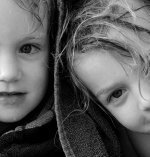RichardJ
Member
After many years of denial I reluctantly have to admit that "digital" might be okay. I have just received my RD1 and my steadfast film-phile tendancies are begining to waver. This is a seriously good camera and all those of you out there still toying with the idea should go and get yourselves one.
I do, however, have a question to those of you experienced with the RD1. All of my images so far seem to be under-exposed by between a half and one full stop.
The details:
Images captured in raw/jpeg.
Camera set for monchrome with no filter.
Highest quality res set.
EV dial set at 0 (obviously).
Lens used Summilux Asph 35mm 1.4.
This issue is not a problem as such because raw conversion allows me to add up to 2 full stops of exposure but I need to know if this is a quirk or a fault. If it's a quirk is it recomended that I compensate with the EV dial or just make adjustments in PS. (Or would it make little difference?)
I attach an image taken with the 35mm Summilux. (my Daughter and her friend)
Approx f4 at 1/200.
This is about 40% full frame
1 stop of exp added in PS plug in.
Thanks for any help on this.
Richard
I do, however, have a question to those of you experienced with the RD1. All of my images so far seem to be under-exposed by between a half and one full stop.
The details:
Images captured in raw/jpeg.
Camera set for monchrome with no filter.
Highest quality res set.
EV dial set at 0 (obviously).
Lens used Summilux Asph 35mm 1.4.
This issue is not a problem as such because raw conversion allows me to add up to 2 full stops of exposure but I need to know if this is a quirk or a fault. If it's a quirk is it recomended that I compensate with the EV dial or just make adjustments in PS. (Or would it make little difference?)
I attach an image taken with the 35mm Summilux. (my Daughter and her friend)
Approx f4 at 1/200.
This is about 40% full frame
1 stop of exp added in PS plug in.
Thanks for any help on this.
Richard


